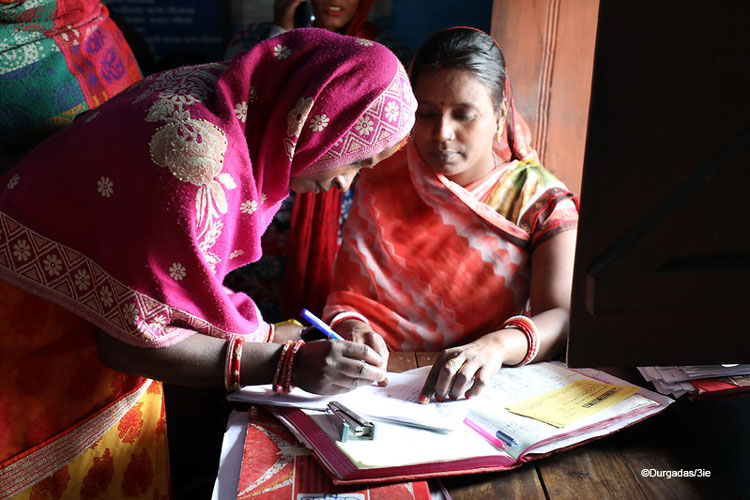
Strengthening the evidence base for programming and policies on women’s groups

Context
Governments and development actors in low- and middle-income countries have invested in supporting groups, particularly women’s self-help groups, as potent anti-poverty platforms. Global investments in group-based development solutions have been increasing in recent times. Microfinance groups in Bangladesh, self-help groups in India, village savings and loan associations in Africa, and village banks in Latin America are examples of such groups. In India alone, the Deendayal Antyodaya Yojana-National Rural Livelihoods Mission reached nearly 87 million rural women through self-help groups in December 2022. In theory, group-based interventions can help improve a range of economic, social and empowerment outcomes for group members. In practice, however, the impact of these programs on their beneficiaries has remained ambiguous.
To present a clearer picture of where the available evidence on group-based livelihoods interventions lies, the Bill & Melinda Gates Foundation commissioned 3ie to synthesize and map the available evidence on the effectiveness and efficiency of group-based livelihoods interventions in rural India. The 3ie evidence gap map describes existing and missing evidence on the effects of livelihoods interventions provided through groups in rural India. It describes the economic, social and empowerment effects of livelihoods interventions provided through groups between January 1996 and April 2018. It includes 129 impact evaluations and 8 systematic reviews.
Evidence
The map shows that despite the increased number of impact evaluations on this topic, particularly those that use experimental methods, some gaps remain. Evidence on intermediate outcomes is much more limited compared to final outcomes. This means that most studies that examine final outcomes are not able to answer why and how impacts occur or do not occur. The evidence is also concentrated on economic outcomes and financial interventions. Complex livelihoods interventions that provide combinations of financial, human and social interventions have less evidence. The existing evidence comes mainly from only two countries: Bangladesh and India. Evidence from similar programs in different contexts, such as Sub-Saharan Africa, is limited. The authors found that although more than half the studies examine programs targeted at women, less than a quarter of them have endeavored to disentangle differential impacts for their prime participants, instead mainly focusing on household-level outcomes.
Synthesis gaps remain in understanding the impact of livelihoods interventions on debt, sources of debt and social outcomes, for which some evidence exists. Even where there is synthesis research available, some important policy questions remain unanswered, such as the implications of group type and context. Existing reviews are outdated, and several new papers have not been incorporated, which could guide decision-makers. This evidence gap map calls for impact evaluations that examine intermediate outcomes more deeply and for an updating of high-quality systematic reviews to address policy questions.
Evidence impacts
Type of impact: Inform discussions of policies and programmes
When subsequent phases of the evaluated programme or policy draw from the findings of the evaluation or review, and/or the study team participates in informing the design of a subsequent phase.
This is one of 3ie’s seven types of evidence use. Impact types are based on what we find in the monitoring data for an evaluation or review. Due to the nature of evidence-informed decision-making and action, 3ie looks for verifiable contributions that our evidence makes, not attribution.
Read our complete evidence impact typology and verification approach here.
Close windowResearchers at the Evidence Consortium on Women’s Groups (ECWG) used findings from the evidence gap map to inform their learning agenda and portfolio evaluation of the Gates Foundation’s investments in South Asia and Africa. The 3ie evidence gap map on group-based interventions has been cited heavily in their Learning Agenda on Women’s Groups document, which seeks to inform the consortium’s priority research questions to address key evidence gaps on the impact, the cost-effectiveness and the implementation of women’s groups at scale. The map has also been cited in the portfolio evaluation of Gates Foundation’s investments that consolidates learnings from ongoing investments and provides recommendations to improve future investments and evaluations of women’s groups and collectives. The ECWG aims to generate and synthesize rigorous evidence in implementing and strengthening programming and policies on women’s groups. It is co-led by the American Institutes for Research and the Population Council and is funded by the Gates Foundation.
Yamini Atmavilas on funding 3ie evidence gap map on group-based livelihoods
Yamini Atmavilas talks about how the 3ie Evidence Gap Map (EGM) on group-based livelihoods has informed the Gates Foundation’s implementation strategy on SHGs in India, ongoing work on NRLM and strategy design for implementation of programs and applying evidence back to the theory of change.
Suggested citation
3ie , 2023. Strengthening the evidence base for programming and policies on women’s groups (online summary), Evidence Impact Summaries. New Delhi: International Initiative for Impact Evaluation (3ie).
Evidence impact summaries aim to demonstrate and encourage the use of evidence to inform programming and policymaking. These reflect the information available to 3ie at the time of posting. Since several factors influence policymaking, the summaries highlight contributions of evidence rather than endorsing a policy or decision or claiming that it can be attributed solely to evidence. If you have any suggestions or updates to improve this summary, please write to influence@3ieimpact.org